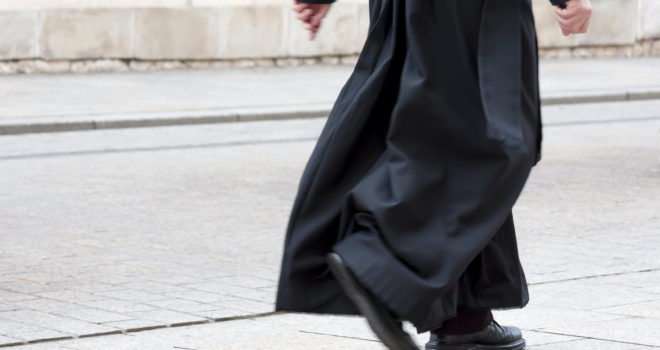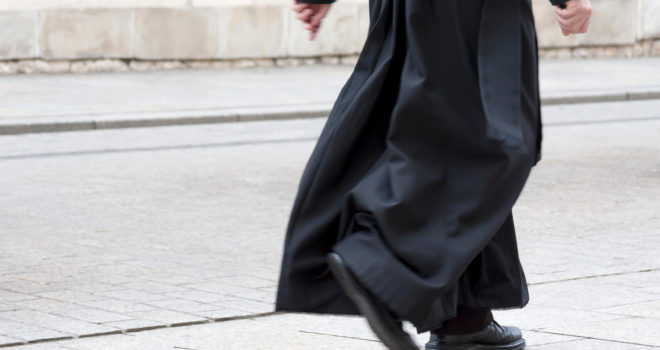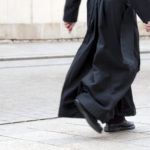On the front cover of the book In Sinu Jesu, Our Lord and Savior Jesus is depicted at the Last Supper. With bread in one hand and the sign of blessing in the other can also be seen an Apostle resting on His shoulder: the person of Saint John the Evangelist. On the table in front of both Jesus and Saint John is a chalice.
This Biblical artistic scene portrays in a graphic version two Sacraments that were instituted in the context of the Last Supper: the Sacrament of the Most Holy Eucharist, as well as the Sacrament of Holy Orders. Both are intimately interconnected. Without the Sacrament of Holy Orders, the Holy Eucharist cannot exist. The Cure of Ars expressed this truth more or less in these words: “No priest, no Mass; no Mass, no Consecration; no Consecration, no Real Presence of Jesus; no Real Presence of Jesus, no Holy Communion, and we become spiritual orphans.”
In order for the Church to exist and function fully, the priesthood is not secondary or an accessory or ornamental, rather, the priesthood is essential. Therefore, it is incumbent upon all, both laity as well as those endowed with Holy Orders, to pray for more priests, but not simply quantity, rather to pray for holy priests, those endowed with the Sacrament of Holy Orders who are sincerely striving to attain holiness of life.
People depend directly on the grace of God, but the grace of God emanates and pours forth through the vessel of the priesthood. God can work even through a poor or mediocre priest. However, usually God’s grace manifests its strength and force more abundantly through the priest who is honestly striving on a daily basis for authentic holiness of life.
How could a dump of a place, ransacked and devastated by the French Revolution, be transformed into a community of fervent and saintly people—this place being the little town of Ars? The response is simple and to the point: the holiness of that one priest who begged the Lord to send him any suffering so as the save his parish and parishioners. That priest was Saint John Marie Vianney—commonly known as the Cure of Ars.
Returning to Saint John the Evangelist, why is it that this saint whose image is depicted on the front cover of the book In Sinu Jesu becomes the entrance gate to what is becoming a modern spiritual classic?
In this book that was written by an Irish Benedictine monk, the person of Saint John returns time and time again. The fundamental reason for the frequent presence of Saint John the Evangelist is this simple reason: Saint John, also nicknamed by Jesus with his brother James as Boanerges—meaning “sons of thunder” — is a model for all priests, as well as Bishops.
Therefore, let us pray fervently for all priests to Jesus the High Priest, to Mary the Mother of priests, but also to Saint John the Evangelist, that priests will contemplate and pray to this saint to help them grow in holiness in their vocation and state—that of the holy priesthood.
The following points accentuate and highlight the characteristics of Saint John as model, friend, pattern and intercessor of priests. Even the worst of priests, living in whatever country, situation or social milieu in the world, can still become a superstar priest. This depends on one primary condition: to trust infinitely in the mercy of God and beg the Lord Jesus, Mary and Saint John for a new heart. It is never too late! Saint Paul reminds us: “Where sin abounds, the mercy of God abounds all the more.” (Romans 5:20) Jesus said to Saint Faustina that the worst sinner can become the greatest saint under one condition: INFINITE TRUST IN THE INFINITE MERCY OF GOD!
What then are the characteristics of Saint John the Evangelist as model and pattern for priests? There are many! May priests utilize this for meditation; may lay people use this in their fervent prayers for priests and future priests.
1. CHOSEN Saint John the Evangelist was chosen by Jesus Christ to be His follower as a priest—Jesus Christ, the Model of all priests and the High Priest Himself, who chooses some individuals to follow Him in the priestly vocation. This choice came simply from a pure and gratuitous love that Jesus had for Saint John, as well as for all priests. Of course, those who are chosen must say yes to the call. God’s love must be accepted freely and without coercion.
2. JOHN SPENT THE WHOLE AFTERNOON WITH JESUS (Jn 1:38-39) In the Gospel of Saint John, the very first chapter after the beautiful Prologue, John the Baptist points to Jesus as the Lamb of God to two of his disciples—John and Andrew. They follow Jesus and He turns around asking what they are searching for? Then Jesus invites them to spend the afternoon with Him. It all started that day about 4:00 p.m.—as Saint John takes care to point out—a critical hour that radically changed their lives. Like John, the priest must have experienced that special day, that hour, that precise moment when Jesus became real to him. That precise moment was that moment of grace when, like John the Evangelist, the priest became convinced of the personal love that Jesus has for him.
3. FROM FISHERS IN LAKE GALILEE TO FISHERS OF MEN Jesus was preaching on the shore of Lake Galilee, then from the boat of Peter to the multitude that stood on the shore. The preaching finished, Jesus told Peter to go out into the deep and to drop the nets. Obedient to the command of the Master, Peter dropped the nets and caught so many fish that he had to summon James and John to help haul the fish to the shore. Then Jesus gave the definite call: “Do not be afraid. From now on you will be fishers of men.” At that moment, Peter, James and John left all to follow Jesus. Like Saint John, in this also critical moment, the priest must learn the true freedom that comes from leaving all to follow Christ. Money, possessions, power, fame, material goods—all are freely surrendered for something much greater: a dynamic and deep friendship with Jesus. Indeed, in having Jesus as the center of their lives, they have all. The priest who focuses upon Christ as the center of his whole existence will experience a perpetual state of joy in the depths of his soul.
4. THE TRANSFIGURATION EXPERIENCE Peter, James and John were privileged in experiencing a foretaste of Heaven. On the top of Mount Tabor, bathed and transfigured in light, Jesus spoke freely with Moses and Elijah. Then the voice of God the Father could be clearly heard: “This is my Beloved Son—listen to Him.” (Mt 17:5) Jesus was encouraging His three best friends with a foretaste of Heavenly glory. The priest lives on earth, but with his mind and heart directed to the glory of Heaven. The virtue of hope will buoy the priest above and beyond the daily trials and crosses that are part and parcel of following Christ.
5. BOANERGES—SONS OF THUNDER In a very loving, kind and charming manner, Jesus gave two of His best friends, James and John, a nickname—Boanerges, meaning “sons of thunder.” The priest should be a son of thunder in that he should thunder against sin, and have a roaring thunder and fire in his heart for love of Jesus! The Lord Jesus Himself declared: “I have come to cast fire on the earth and I am not at peace until that fire be enkindled.” (Lk 12:49)
6. THE LAST SUPPER: JOHN RESTS ON THE HEART OF JESUS One of the patron saints for the Sacred Heart of Jesus is none other than Saint John the Evangelist. Why? One of the primary reasons is that there at the Last Supper, Saint John leaned over to rest his head on the Sacred Heart of Jesus. John listened to Jesus’ heartbeats of love. Every priest is summoned to draw close to Christ and to rest on His Sacred Heart. Jesus invites: “Come to me all of you and I will give you rest; for I am meek and humble of heart, and you will find rest for your souls. For my yoke is easy and my burden is light.” (Mt 11:28-30) Like John, may the priest find rest in the Sacred Heart of Jesus—his true refuge and haven against the storms of life.
7. AT PRAYER, JOHN FALLS ASLEEP It is a Biblical-Gospel truth: John fell asleep when Jesus really needed his prayer and friendship. John was not perfect! There is the perennial danger for all Catholics—and this does include the priest—of falling asleep in prayer when we should be wide awake and vigilant. The primary reason for the fall of a priest is precisely this: lack of prayer and lack of fervent prayer. Indeed, prayer is truly Friendship with Jesus. May priests learn the art of praying even in the difficult moments of desolation. Indeed the spirit is willing but the flesh is weak.
8. AT THE FOOT OF THE CROSS There at the foot of the cross on Calvary that first Good Friday were present three of Jesus’ best of friends: The Magdalene, John the Evangelist, and Jesus’ Mother, Our Lady of Sorrows. Venerable Archbishop Fulton J. Sheen depicts the three as representing three different styles of life: Mary Magdalene represents the true Penitent—the sinner repentant and sorrowful for the sins of their past. Our Lady represents total Innocence—the Immaculate one. Saint John, according to Sheen, represents the Priesthood. Quite understandable given that John stands under the cross, as it were offering Jesus, the Innocent Victim, to God the Father for the salvation of the world. Every Mass that is offered, in any time or place, the priest transports back to Calvary with Jesus hanging on the cross. The fruits of Calvary and the Mass are timeless and infinite!
9. JESUS: MARY AND SAINT JOHN From the pulpit of the cross, Jesus delivers His last and greatest sermon. These would be His famous “Seven Last Words…” One of these words or short phrases was directed to His Mother Mary and His Beloved Disciple, Saint John. Jesus said: “Woman behold thy son; son behold thy Mother; then the beloved disciple took Mary into his home.” (Jn 19:26-27) Like Saint John, the Beloved disciple and Apostle, every priest must invite Mary into his home. By home, in a spiritual but a very profound sense, is meant their very heart. John invited Mary into his heart to be his loving Mother forever. Every successful man must have a woman behind him. In the case of the priest that woman is the Blessed Virgin Mary—his loving and tender Heavenly Mother.
10. HIS HEART WAS PIERCED WITH THE LANCE: BLOOD AND WATER CAME GUSHING FORTH After Jesus breathed forth his last, the soldier came and pierced His side with the lance; then Blood and water came gushing forth. Saint John was an eye-witness of this heart-rending event. The Church teaches that the Blood and water symbolize the Church and its Sacramental life. Most specifically, the Blood and water symbolize Baptism and Confession (the water), and the most Holy Eucharist (the Blood). The priest must be motivated with great love to celebrate the Holy Sacrifice of the Mass. Also, the priest should have a great desire to bring back wandering souls to Jesus the Good Shepherd by means of the Sacrament of Reconciliation.
Our prayer, desire and hope is that Saint John the Evangelist, presented as a model for priests in In Sinu Jesus, will serve as a model and pattern for every priest to meditate upon, pray over and imitate. More than anything else, Saint John allowed the love of Jesus to penetrate his whole being, to the very fiber of his being. For Saint John, and hopefully for every priest, Jesus is the end all, the alpha and omega, the principle and foundation of his existence. For Saint John, Jesus was his Lord and God, his Master and Teacher, his Redeemer and Savior, and most especially, his Best Friend. May all priests take Saint John as a model priest on which to pattern the essence of their priestly life. Indeed, Jesus is and always will be the BEST OF FRIENDS WHO WILL NEVER FAIL US!!!
✠
Editor’s note: this article was first published on Fr. Broom’s blog













